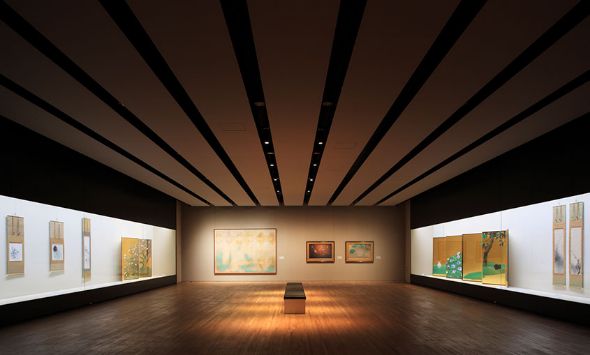Delighting in Japan’s Culture of the Four Seasons
Sophie Richard wanders around Japan
Words by Sophie Richard

Delighting in Japan’s Culture of the Four Seasons
Representations of nature and of the four seasons feature in countless Japanese artworks of all periods and media. The natural world and the changing seasons appear not only in paintings but also in poetry and in all the traditional arts; it even pervades gastronomical experiences. Indeed, when it comes to describing Japanese culture, the significant role occupied by nature and the four seasons is not only readily underlined by the Japanese themselves, it is often cited by foreigners too.
It is also noticeable in the museum world, as displays may rotate to match the season for example. One museum in Tokyo in particular is noticeably apt at giving visitors an opportunity to admire representations of Japan’s natural beauty and its artists’ sensitivity to the seasons: the Yamatane Museum of Art.
Founded by businessman and patron of artists Yamazaki Taneji in 1966, and relocated to its present site in 2009, the museum focuses on nihonga, Japanese-style painting from the Meiji period onwards. The titles of numerous works in the collection testify to the artists strong focus on the classic themes of the seasons and nature: Dancing in the Flames (1925) and Camellia Petals Scattering (1929) by Hayami Gyoshū (both are Important Cultural Properties), Autumn Plants and Quails (early 19th century) by Sakai Hōitsu (Important Art Object), or Firefly (1913) and Snowy Day (1948) by Uemura Shōen. It is said that the painter Yokoyama Taikan himself encouraged Yamazaki to realise his dream of opening a museum; paintings by Taikan include Spring Stream and Autumn Colours (c.1938) and Divine Spirit: Mount Fuji (1952).





The collection contains many other gems of nihonga, literally ‘Japanese painting’, a style of painting characterised by the use of traditional materials and techniques. The works are executed on silk or washi paper, with colours derived from mineral pigments, pulverized oyster or clam shells, and animal glue as the binding element. Gold and silver, sprinkled in a fine dust or applied as a leaf, are often used to add a glittering effect. Due to the fragility of the natural pigments, all works at the Yamatane Museum are presented behind glass yet it is still possible to observe the paintings closely. On a recent visit I could see how the malachite used for making green, or the azurite for blue, sparkle like jewels on the surface. Thanks to the sensitive lighting, I could admire the paintings delicate colouring and hues of gold.
On view there were sets of paintings of the four seasons, a traditional grouping, as well as single works concentrating on a distinctive facet of spring, summer, autumn or winter. My eye was caught by Emerald Mosses and Verdant Turf by Hayami Gyoshū (1928), a striking pair of folding screens with a bold, luminous gold leaf background against which the artist painted delicate pale blue hydrangeas, deep green grass and a black cat adding to the decorative effect. I was also enchanted by Autumn Fruit by Kobayashi Kokei (1934), a sensitive depiction of the branch of a persimmon tree. The fruits’ vivid vermilion and the leaves rendered in mottled shades of gold eloquently evoke the deepening of the season. The work conveys a sense of the autumnal mood.


As the works can only be on display for a period of two months a year to preserve their condition, the museum organises five to six different exhibitions a year. They can focus on a particular iconographic theme, a single artist or a group of artists. The range of painters presented and the exhibitions’ engaging themes provide a fascinating insight into Japanese aesthetics, the evolution from traditional to modern landscape painting in Japan and the artists’ focused gaze on the subtle changes of its seasons.
The museum reserves a special treat for visitors at the end of their visit as in the museum café it is possible to enjoy a selection of unique wagashi (Japanese tea cakes) especially created for each exhibition. Before each show the renowned specialist confectioner Kikuya, in consultation with the museum curators, creates five wagashi inspired by some of the paintings and themes in the exhibition. These edible miniature works of art also celebrate the beauty of nature and of the changing seasons.



Yamatane Museum of Art
- Place
- 3-12-36 Hiroo, Shibuya-ku, Tokyo 150-0012
- Time
- 10:00 a.m. - 5:00 p.m. (Last Admission at 4:30 p.m.)
Reservation is not required. - Closed
- Mondays (closed on the day after a national holiday), December 29 - January 2, and closed for exhibition installations. Call to confirm schedules.

